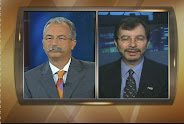The stock market rally since early March appears to have three distinct phases to it.
The first phase was the backing off from the economic abyss. The second phase was a bounce to fair value normalcy. The third phase (the one we are in now) is what I would call the return to business as usual phase (or “Recession. What recession?).
From where I sit, the first two phases were justified on many levels. Both phases featured massive amounts of government intervention combined with strong technicals to produce a rally to fair value. The elimination of the tail risk of the Great Depression II was followed by the above consensus macro economic readings (my MERI indicator), which was reinforced by the above consensus earnings results of 2Q09. Stocks rose to a reasonable fair value. So far, so good.
Unfortunately, at this point the seeds of questionable earlier decisions began to bear fruit. (Now, this going to sound very libertarian, so here goes.) Instead of pursuing the necessary cleansing process that all excesses produce, the Obama administration (which includes the US Treasury and the “independent” Federal Reserve) opted for a massive debt transference from the private to the public sector with the hope that time will heal all wounds. Along with this decision to socialize the bad behavior of the private sector most responsible for the crisis, the financial services industry, the Obama administration supported its core structure built on the laissez-faire era of the past two decades, accepting the largely unsubstantiated argument that financial innovation is a vital and necessary good for the economy.
With the government’s tacit support of the status quo, the investment mood shifted from fear and concern to hope and then enthusiasm.
The evidence of this mood shift back to the animal spirits days of yore came from a logical source – the financial services industry, the very sector of the global economy that provided the financial innovation grease to the out of control freight train of credit. And what better symbolic locomotive than Goldman Sachs, whose earnings report of July 14th whistled the bad old days were back in action. At this point, the Obama administration swung into action – with silence.
With its absence of outrage, the increasingly politically tone deaf Obama administration sent the public policy signal that its okay to bring the world economy to its knees, its okay to get bailed out with taxpayer money, its okay to shrink the competitive landscape (via Bear and Lehman’s demise), and its okay to return to the way things were – big profits and in your face fat bonuses.
The product of this wink and nod to Wall Street was the backlash at town hall meetings, which were as much about fairness as they were about healthcare reform concerns, a paranoid view of government, and a reactionary view of what constitutes being an American. It also produced an enthusiasm for stocks and an implied return to the bad old days.
Investment Strategy Implications
When you combine all these factors with the massive amount of investment capital ($3.5 trillion) still sitting in the near zero interest rate money market sidelines, the rising belief among many institutional investors that P/Es above their historical average are justified in the current low inflation environment, and the fledgling confidence that the global economy is on the mend* (along with the blind faith that the economic data from China is real), it is understandable how valuation levels could get to where they are today – stretched.
The investment question then becomes, “Is this a solid enough foundation upon which sustainable bull markets are built?” I have my doubts.
*I suggest reading Nouriel Roubini's comments in yesterday's FT.




























